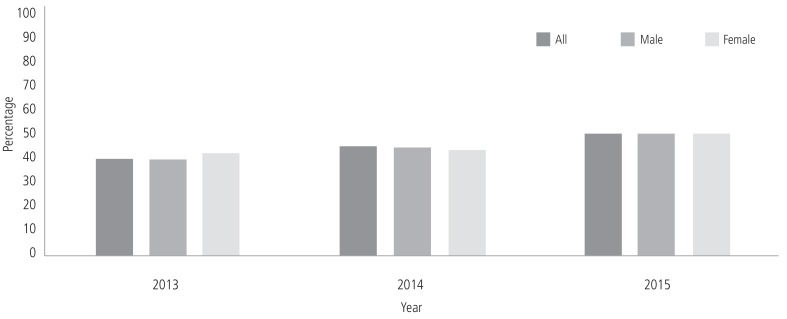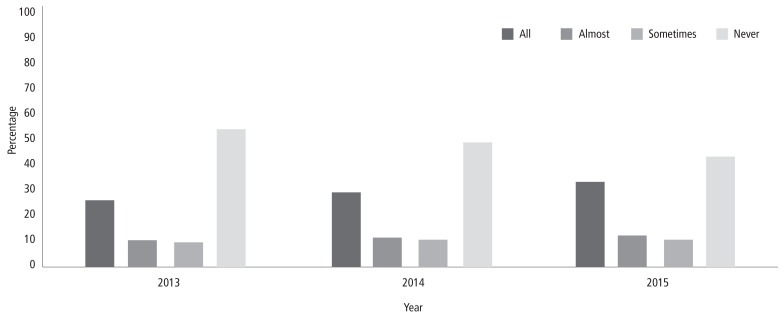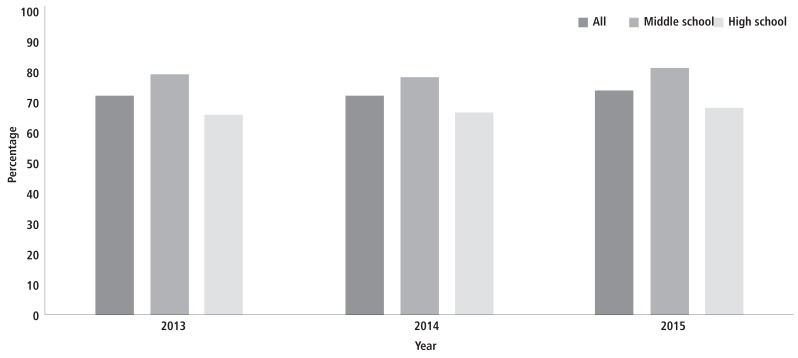Introduction
Contraception in adolescents is an important issue in public health around the world. For example, in the US, the number of adolescents who become pregnant is estimated to be more than 600,000 to 750,000 every year, and 82% of these pregnancies are unplanned [1]. Teen pregnancy due to unprotected sexual activity is associated with a high risk of maternal and neonatal morbidity and mortality, as well as unsafe abortion. It may also lead to an adolescentŌĆÖs negative lifelong health and fertility outcomes. Furthermore, teen pregnancy may interfere with oneŌĆÖs social and educational life in part to the prejudice of society that such adolescents may be a bad influence on others. Consequently, the burden to society from these negative sequelae of teen pregnancies is substantial.
In the US, about half of high school students have experienced sexual intercourse [2]. Although many adolescents reported using some type of contraceptive methods, they seldom choose and used contraception effectively. A high rate (82%) of unplanned pregnancies shows the need for effective contraception methods and education in adolescents [3].
In Korea, the overall prevalence of having sexual activity during the adolescent period is about 5%, and 9% of these sexually active adolescents have experienced pregnancies [4]. Because girls who get pregnant commonly undergo an induced abortion or leave school, contraception in adolescents should be addressed with high priority. Nevertheless, there have been very few studies evaluating the status of contraceptive use during adolescence in Korea [5,6], which is an important process in order to develop interventions for enhancing contraceptive use among adolescents.
This study was conducted to evaluate the recent trends in contraceptive use among Korean adolescents using the results from a nationwide adolescent health survey.
Materials and methods
The source of data was achieved from the Korean Youth Risk Behavior Web-based Survey. This is a cross-sectional survey that has been conducted by the Korean government annually since 2005, to monitor health-related behaviors among Korean adolescents. This survey applied a stratified, multi-stage, cluster-sampling design in order to ensure a nationally representative sample of Korean adolescents. Approximately 80,000 students aged 13 to 18 years old in middle school and high school were randomly selected each year for this survey. Each participant accessed the website anonymously using a previously assigned certificate number. Data from 2013 to 2015 were analyzed for this study, for which the total number of participants in the survey during this period was 212,538 [7]. A three-year study duration was selected to reflect most recent trends and to consider school system among middle and high school students in Korea. Weighted values were given for reliability of the data.
The questionnaire for the survey was consisted of multiple questions assessing demographic characteristics, and 14 areas of health-risk behaviors. Among them, answers to eight questions were reviewed for the outcome variables of this study as followings: 1) "Have you ever had any experience of sexual intercourse?", 2) "When was the time of your first intercourse?", 3) "Have you ever experienced pregnancy?", 4) "Have you ever experienced an artificial abortion?", 5) "Do you use any kind of contraception?", 6) "How frequently do you use contraception?", 7) "What is your most commonly used contraceptive method?", and 8) "Have you ever received any kind of sex education at school in the previous 12 months?".
Results
During the study period, the percentage of adolescents who were reported being sexually active ranged from 5.0% to 5.3%. The mean age at first sexual activity was between 12.8 and 13.2 years old, and was similar during all three years. Among sexually active girls, 0.2% reported having experienced pregnancy, and 66.1% to 73.6% of them underwent induced abortion (data not shown).
Fig. 1 presents the rate of contraceptive use. Contraceptive use among sexually active adolescents showed a steady increase from 2013 to 2015 in both boys and girls (about 10% over 2 years); nonetheless, the proportion still did not reach half of all adolescents having sexual intercourse. Fig. 2 shows the frequency of contraceptive use. In the last three years, the percentage of "always use" increased from 26.1% to 33%, whereas that of "never use" decreased from 53.3% to 43.5%. The percentage of the items "almost always use" or "sometimes use" of contraception were similar across the three years of the study period.
As shown in Table 1, the most frequently used contraceptive method was condoms, followed by withdrawal and oral contraceptives. The rate of condom use increased by 5% over recent two years, while that of oral contraceptive use decreased by 3.6% over the same period. The rate of use of withdrawal and other methods remained similar. Whilst condoms were answered as being most frequently used, the use of more effective hormonal methods such as oral contraceptives was lower, ranging around 10%, and highly effective long-acting reversible contraceptives were the least used, ranging at a rate of only 1% to 2%. Contraceptive methods with a high failure of contraception rate such as withdrawal and periodic abstinence were still preferred by 20% of adolescents.
Fig. 3 depicts the percentage of adolescents provided with sex education in school during the previous 12 months. There was a slight increase, from 71.6% to 73.3%, during the study period. While the prevalence of sexual activity appears to be higher in later adolescence (2.9% in middle school vs. 6.8% in high school in 2015), the proportion of sex education appears to be much lower in high school compared with middle school, as seen in Fig. 3.
Discussion
Although the prevalence of having engaged in sexual intercourse among adolescents in Korea is lower than that in other western countries, the proportion of girls who underwent an abortion was very high in the present study (around 70%), compared to with 26% in the US in 2010 in the present study [8]. Moreover, the adolescent pregnancy rate has been remained unchanged in Korea, while the rate in the US has declined markedly [9]. In these respects, the need for adequate contraceptive use seems to be much greater in Korea.
In the present study, the rate of "any use" of any contraceptive method was less than 60% in both genders, despite the recent increases. This rate is markedly lower than in the US, where the rate of "ever-use" of contraception in girls aged 15 to 19 was 98.9% during 2006 to 2010 [1]. Moreover, the proportions of Korean adolescents who used a contraceptive method consistently were still low. The proportion of adolescents who did not use any contraceptive was much higher in the current study than that seen in recent studies of 24 countries (13.2%) [10] and the US (16.8%) [11]. This finding suggests that focused education about responsible sexual behavior should be implemented to prevent unprotected intercourse among Korean adolescents.
The most commonly used contraceptive method by Korean adolescents was the condoms (about 70%), which is consistent with the findings in the US. The rate of "ever-use" of condoms in adolescents in the US was 98.9%. Condoms can be an effective contraceptive option if consistently and correctively used, and moreover, unlike withdrawl, condoms protects against sexually transmitted infections [1]. Therefore, it could be recommended to use condoms regardless of the use of additional contraceptive methods. The second most common contraceptive method used by Korean adolescents was withdrawal, which is also similar to the US study [1]. However, while experience with oral contraceptives was common in the US, with a similar rate of use as withdrawal, the rate of use appeared to be apparently lower in Korea (15.0% vs. 9.2% in 2015). This difference may be a result of the negative attitudes among Korean women towards the use of hormonal contraceptives related to concerns about weight gain, permanent infertility and being considered promiscuous [12]. The accessibility of hormonal contraception may also be lower for Korean female adolescents because sexual activity in adolescents is frowned upon, and because some types require prescriptions. Additional barriers to the use of hormonal contraception could be the higher cost than condoms and the need to take regular daily medication, which may not suit some impulsive sexual activities. In addition, the recent decreasing trend in oral contraceptive use might be related to an increased focus on announcement for venous thromboembolic risks by the Korean media. Use of more reliable contraceptive methods, rather than withdrawal, should be emphasized more during sexual education in Korea.
Sexual education can play an important role in reducing adolescent sexual risk behaviors and promoting sexual health [13]. Although the contents of sexual education programs vary across schools and were not elucidated in the present study, the recent improvement in the rate and frequency of contraceptive use might be associated with a higher rate of sex education. However, considering that the rate of contraception and the proportion of consistent contraceptive use is still low, and that the use of unreliable contraceptive methods is still prevalent, greater efforts should be made to organize and deliver the most helpful and informative sex education programs.
Taking into account that the average age of sexual activity initiation in this study was reported to be as early as 12 years old, it seems clear that sexual education should be started at an earlier age. The contents should be appropriate for each age group, since the knowledge, apprehension and attitudes towards sexual activity may vary among different age groups. For example, knowing how to say no to unwanted sex may be most important for younger adolescents. Sexual education contents should adress the knowledge of how unprotected sex can cause sexually transmitted infections, unwanted pregnancy, and other negative consequences, and it should teach students to know the possible consequences of their sexual activity, and how to be able to take responsibility for them. Although abstinence is considered the best contraceptive method when not ready for sex, teaching adolescents about various types of contraceptive methods, including the efficacy rates of each type, and how to correctly use them, is needed for practical reasons.
The current study has several strengths. First, the sample size (about 80,000 students in each year) was much larger than those of most other studies; secondly, the response rate was quite high (95%). In addition, our sample is likely to be a representative of Korean adolescents because the data used were taken from a government-sponsored population-based survey of adolescent health using stratification and weighted values.
However, our findings should be considered within the context of some limitations. First, the cross-sectional nature of the data does not allow for causal inference. Second, the data are self-reported, and therefore, rely on the willingness of participants to provide accurate information. Despite the lack of obligation for the students to participate in the study and the assurance of anonymity, the possibility of self-report bias must still be considered. In addition, because the data were collected in schools, and adolescents who previously left or dropped out of school were not included, may lead to selection bias. This might be a limitation for the generalization of our results.
In conclusion, the present study demonstrates the status of contraceptive use among adolescents in Korea. Our data have the potential to help healthcare providers to formulate policies and develop interventions for encouraging the consistent and correct use of effective contraception among sexually active Korean adolescents.



























